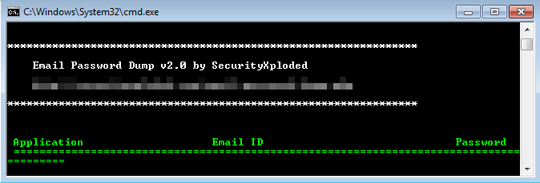HKTL_PWDUMP.GBTS
TrojanSpy:Win32/Skeeyah.A!rfn (Microsoft); Win32/SecurityXploded.X potentially unsafe (ESET); Trojan-PSW.Win32.Adrop.n (Kaspersky);
Windows


Threat Type: Hacking Tool
Destructiveness: No
Encrypted: Yes
In the wild: Yes
OVERVIEW
Downloaded from the Internet, Dropped by other malware
This hacking tool arrives on a system as a file dropped by other malware or as a file downloaded unknowingly by users when visiting malicious sites.
It uses a user interface (UI).
TECHNICAL DETAILS
2195456 bytes
EXE
Armadillo
Yes
17 Jun 2016
Steals information
Arrival Details
This hacking tool arrives on a system as a file dropped by other malware or as a file downloaded unknowingly by users when visiting malicious sites.
Information Theft
This hacking tool gathers the following data:
- Login credentials from the following applications:
- Microsoft Outlook Express
- Microsoft Outlook 2002/XP/2003/2007/2010/2013
- Mozilla Thunderbird
- Windows Live Mail 2012
- IncrediMail
- Opera Mail
- The Bat!
- Foxmail v6.x - v7.x
- Windows Live Messenger
- MSN Messenger
- Google Talk
- GMail Notifier
- PaltalkScene IM
- Pidgin Messenger
- Miranda Messenger
- Windows Credential Manager
Other Details
This hacking tool uses the following user interfaces (UIs):
It does the following:
- It may create a dump file based on the parameter used upon execution of the application.
SOLUTION
9.800
9.592.02
13 Dec 2012
9.593.00
14 Dec 2012
Step 1
Before doing any scans, Windows XP, Windows Vista, and Windows 7 users must disable System Restore to allow full scanning of their computers.
Step 2
Note that not all files, folders, and registry keys and entries are installed on your computer during this malware's/spyware's/grayware's execution. This may be due to incomplete installation or other operating system conditions. If you do not find the same files/folders/registry information, please proceed to the next step.
Step 3
Scan your computer with your Trend Micro product to delete files detected as HKTL_PWDUMP.GBTS. If the detected files have already been cleaned, deleted, or quarantined by your Trend Micro product, no further step is required. You may opt to simply delete the quarantined files. Please check this Knowledge Base page for more information.
Did this description help? Tell us how we did.


